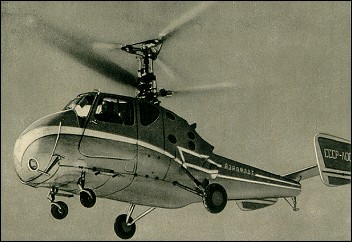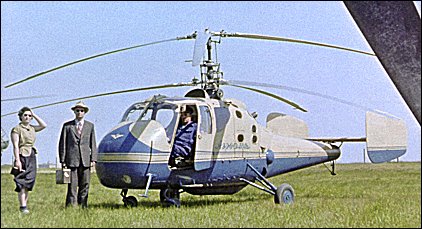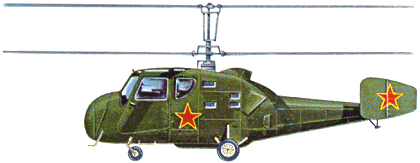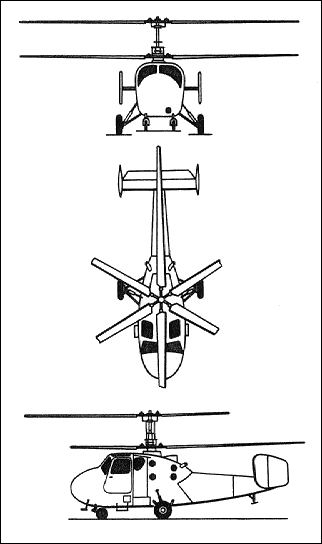Post by Stingray on Jul 11, 2008 18:52:47 GMT -4
Kamov Ka-18
1958
--------------------------------------------------------------------------------

www.aviastar.org/helicopters_eng/ka-18.php
The Kamov Ka-18 (NATO reporting name Hog) was a four-seat development of the Ka-15M; it retained the same engine, rotor, transmission and control systems and landing gear. The main changes were to the fuselage, which was stretched to make room for two passengers and a baggage compartment. The prototype was completed in 1956 and flight testing began early in 1957. A limited number of the Ka-18 were built for use as air ambulances and for forestry patrol, geological survey and agricultural work. Towards the end of 1960, the production aircraft were given a 275hp AI-14VF engine (VF stands for Vertolet Forsirovannie meaning helicopter with turbocharger) instead of the AI-14V, thus enabling the payload to be increased by about 100kg and the ceiling by 300-500m. The chord of the endplate finswas also enlarged.
The Ka-18 was evaluated but not adopted by the Soviet Air Force.
--G.Apostolo "The Illustrated Encyclopedia of Helicopters", 1984

Stretched all-weather Ka-15; up to 4 seats or internal stretcher and doctor or two rear passengers; alternatively 200kg cargo. Nose no longer transparent; doors hinged at rear; 176 litres of fuel in floor tanks; extended rear fuselage and fins/rudders of much greater chord; whole aircraft cleaned up aerodynamically. Alcohol de-icing of blades and windscreen, exhaust heater muff feeds hot air on demand to cabin. First flown early 1957. State trials 1958, produced with blind-flying insts and option of 70-litre ferry tanks for AV-MF, VVS and Aeroflot. Uka-18 dual control, role equipment for survey and vineyard spraying. ASCC reporting name "Hog".
--Bill Gunston "The Osprey's Encyclopedia of Russian Aircraft", 2000

Technical data for Ka-18
Crew: 1, passengers: 3, engine: 1 x AI-14VF pistone engine, rated at 200kW, rotor diameter: 10.0m, length: 10.0m, height: 3.4m, take-off weight: 1502kg, max speed: 160km/h, cruising speed: 130km/h, service ceiling: 3500m, range with max fuel: 450km, range with max payload: 300km

1958
--------------------------------------------------------------------------------

www.aviastar.org/helicopters_eng/ka-18.php
The Kamov Ka-18 (NATO reporting name Hog) was a four-seat development of the Ka-15M; it retained the same engine, rotor, transmission and control systems and landing gear. The main changes were to the fuselage, which was stretched to make room for two passengers and a baggage compartment. The prototype was completed in 1956 and flight testing began early in 1957. A limited number of the Ka-18 were built for use as air ambulances and for forestry patrol, geological survey and agricultural work. Towards the end of 1960, the production aircraft were given a 275hp AI-14VF engine (VF stands for Vertolet Forsirovannie meaning helicopter with turbocharger) instead of the AI-14V, thus enabling the payload to be increased by about 100kg and the ceiling by 300-500m. The chord of the endplate finswas also enlarged.
The Ka-18 was evaluated but not adopted by the Soviet Air Force.
--G.Apostolo "The Illustrated Encyclopedia of Helicopters", 1984

Stretched all-weather Ka-15; up to 4 seats or internal stretcher and doctor or two rear passengers; alternatively 200kg cargo. Nose no longer transparent; doors hinged at rear; 176 litres of fuel in floor tanks; extended rear fuselage and fins/rudders of much greater chord; whole aircraft cleaned up aerodynamically. Alcohol de-icing of blades and windscreen, exhaust heater muff feeds hot air on demand to cabin. First flown early 1957. State trials 1958, produced with blind-flying insts and option of 70-litre ferry tanks for AV-MF, VVS and Aeroflot. Uka-18 dual control, role equipment for survey and vineyard spraying. ASCC reporting name "Hog".
--Bill Gunston "The Osprey's Encyclopedia of Russian Aircraft", 2000

Technical data for Ka-18
Crew: 1, passengers: 3, engine: 1 x AI-14VF pistone engine, rated at 200kW, rotor diameter: 10.0m, length: 10.0m, height: 3.4m, take-off weight: 1502kg, max speed: 160km/h, cruising speed: 130km/h, service ceiling: 3500m, range with max fuel: 450km, range with max payload: 300km






